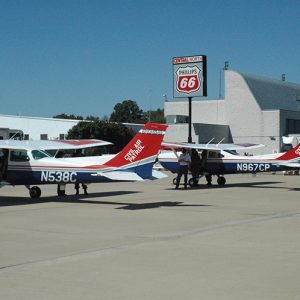calsfoundation@cals.org
Civil Air Patrol Arkansas Wing
The Arkansas Wing is one of the fifty-two chapters—including all the states, Puerto Rico, and the District of Columbia—that make up the Civil Air Patrol (CAP), which is the civilian volunteer auxiliary of the U.S. Air Force. The Civil Air Patrol was formed on December 1, 1941, for the purpose of conducting emergency service operations including search and rescue, homeland security, and disaster relief missions. Today, the CAP continues to perform those duties, as well as educating the public and its members about the value of aerospace and operating a cadet program for youth leadership development.
In late 1941, Arkansas pilots foresaw the need to form an aviation unit to take the place of the Arkansas National Guard’s 154th Observation Squadron, which had been federalized the previous year. Spearheaded by J. Gilbert Leigh of Little Rock (Pulaski County), the Civil Defense Flying Service was authorized by Governor Homer Adkins in September 1941 as part of the Arkansas State Defense Council. While Arkansas continued to form its own flying unit, plans were coming together to form a national flying organization, and on December 1, 1941, the Civil Air Patrol was formed as part of the federal Office of Civilian Defense. Further efforts to form an independent organization in Arkansas were immediately dropped, and Leigh became the first commander of the Arkansas Wing of the Civil Air Patrol.
Local units, known as squadrons, began to be organized, and the wing’s first mission took place in late April 1942 when it was asked to transport several thousand sugar-ration forms to Blytheville (Mississippi County) and Van Buren (Crawford County) after the supplies managed by local committees were exhausted. In early 1942, German U-boats were causing extensive shipping problems in the Atlantic Ocean, and neither the U.S. Navy nor the Army Air Corps had enough airplanes to patrol America’s coastline. Beginning in February 1942, the Civil Air Patrol, under military control, opened twenty-one bases along the Eastern and Gulf coasts to conduct patrols in search of German submarines and to assist ships in distress; these were active until August 1943. Arkansas Wing members were assigned to coastal patrol duty as early as July 1942, and while the total number who served is unknown, eleven wing members earned Army Air Medals for performing at least 200 hours of over-water patrols.
Back in Arkansas, the wing was involved in other operations during the remainder of 1942, including performing forest fire patrols and assisting in blackout tests. However, not until the Arkansas River floods of 1943 did it participate in a major mission. During this event, the wing performed a wide range of tasks including carrying U.S. mail, patrolling levees from the air and on the ground, transporting critical parts and personnel, spotting people stranded by the floodwaters, and conducting aerial photography. Disaster response remains a major component of Arkansas Wing operations; wing members were activated and sent to Louisiana and Mississippi after Hurricane Katrina in 2005.
The Civil Air Patrol is best known for performing searches for lost aircraft, and the Arkansas Wing’s first such mission occurred after an Army C-47 plane went missing on September 30, 1943. This first search may have been one of the longest performed by the wing, as it was not until November 27 that the wing found the wreckage west of Hot Springs (Garland County). The wing has also been responsible for the rescue of crash survivors, such as the rescue of a mother and her son found nearly frozen after their plane crashed on Rich Mountain in December 1972.
On April 29, 1943, the Civil Air Patrol was transferred from the Office of Civilian Defense to the Army Air Force. The Civil Air Patrol officially became the volunteer civilian auxiliary of the U.S. Air Force on May 26, 1948. For most of its history, the Arkansas Wing has had its headquarters at Adams Field in Little Rock (Pulaski County) in the old terminal annex, which was built in 1940. In order to make room for the expansion of the Little Rock Air Center facility in 1982, a 3,800-square-foot building was constructed for the wing on the north side of the airport. In October, 2002 the wing moved to the former Air National Guard Armory on the west side of the airport at 2201 Crisp Drive.
The wing was part of the Department of Public Safety from 1971 to 1981, when it was transferred to the Arkansas Military Department, which provides a Civil Air Patrol services coordinator to oversee the spending of state funds. In recognition of the services provided to the state, the Arkansas legislature passed Act 471 in 2003, which allows Civil Air Patrol members who are employed by a city, county, or state agency to take up to fifteen days of paid leave per year for Civil Air Patrol training or emergency and rescue services. Five Arkansas Wing members have died while in Civil Air Patrol service.
The Arkansas Wing started a cadet program for youths in June 1943, which is open to youths twelve to twenty-one years of age.
For additional information:
Arkansas Wing, Civil Air Patrol. https://arwg.cap.gov/ (accessed March 8, 2022).
Davis, Charles T. “The CAP: Our Light Plane ‘Air Force’ Plays an Important Role in the Aviation Effort.” Arkansas Gazette, November 27, 1960, p. 2E.
Deane, Ernie. “The CAP—Two Decades of Service.” Arkansas Gazette, December 3, 1961, p. 5E.
Faris, Ann. “Arkansas Civil Air Patrol on the Move.” Arkansas Democrat Magazine, November 15, 1953, pp. 6–7.
Forster, Bobbie. “Fighting Floods from the Air.” Arkansas Gazette Magazine, June 20, 1943, pp. 4–5.
Neprud, Robert E. Flying Minute Men: The Story of Civil Air Patrol. New York: Duell, Sloan and Pearce, 1948.
Steketee, Drew. Civil Air Patrol: Missions for America…for 65 Years. Nashville, TN: Turner Publishing Co., 2007.
D. Blake Sasse
Maumelle, Arkansas
 154th Observation Squadron
154th Observation Squadron  CAP Aircraft
CAP Aircraft 




Comments
No comments on this entry yet.